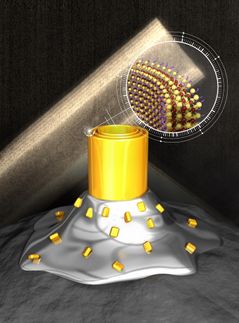Water treatment: nanotubes capture steroid hormones
Removal of micropollutants in electrochemical membrane reactor with carbon nanotube membrane
Advertisement
Supplying people around the world with clean water is one of the major challenges of the present and future. Wastewater contains various micropollutants, i.e. organic and inorganic substances that occur in low concentrations but still have a harmful effect on humans and the environment. Particular risks are posed by endocrine disruptors, i.e. substances that can affect the hormone system, such as steroid hormones. These are widely used in medicines and contraceptives, among other things. They are difficult to detect in water, but can severely disrupt human health and the ecological balance of bodies of water.
Oxidation enables the degradation of micropollutants
Steroid hormones can neither be detected nor removed using conventional water treatment methods. Electrochemical oxidation (EO) is increasingly recognized as an advanced approach: EO systems consist of an anode and a cathode, connected to an external power source. The electrical energy of the electrodes is changed (modulated), which leads to oxidation on the anode surface and breaks down the impurities. Electrochemical membrane reactors (EMR) utilize the possibilities of EO even more effectively: a conductive membrane serves as a flow-through electrode, which improves the transport of substances. In addition, active sites are fully accessible to the reacting molecules.
Carbon nanotubes have unique physical and chemical properties
Researchers at the Institute for Advanced Membrane Technology (IAMT) at KIT, together with scientists at the University of California, Los Angeles, and at the Hebrew University of Jerusalem, have now further elucidated the mechanisms in EMR that are difficult to understand: As the researchers report in the special issue "Water Treatment and Harvesting" of the journal Nature Communications, they investigated the degradation of steroid hormone micropollutants in an EMR with a carbon nanotube membrane. Carbon nanotubes (CNTs) have diameters in the nanometer range and possess unique physical and chemical properties: "Their high conductivity enables efficient electron transfer," explains Andrea Iris Schäfer, Professor of Water Process Engineering and Head of the IAMT at KIT. "Thanks to their nanostructure, CNTs have an extraordinarily large surface area and therefore enormous potential for the adsorption of various organic compounds, which facilitates subsequent electrochemical reactions."
In their study, the researchers used state-of-the-art analytical methods to investigate the complex interplay of adsorption and desorption, electrochemical reactions and the formation of by-products in an EMR. "We found that the preceding adsorption of steroid hormones, i.e. their accumulation on the surface of the CNT, does not limit the subsequent degradation of the hormones," reports Dr. Siqi Liu, postdoc at the IAMT. "We attribute this to the rapid adsorption and effective mass transport." The analytical approach of the study also makes it easier to determine the factors limiting hormone degradation and changing conditions. "Our study clarifies some fundamental mechanisms in electrochemical membrane reactors and provides valuable insights to further develop electrochemical strategies for the removal of micropollutants in water," Schäfer summarizes.
Note: This article has been translated using a computer system without human intervention. LUMITOS offers these automatic translations to present a wider range of current news. Since this article has been translated with automatic translation, it is possible that it contains errors in vocabulary, syntax or grammar. The original article in German can be found here.






























































